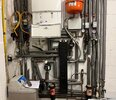now you enter a different aspect of delta t. The method of heat transfer now depends upon the barrier to air (the top layer of flooring) and the heat loss you have downward. What is the total volume of liquid of liquid in the coil, what temperature is that, what are the loses....all this need collating to reach an answer. You also need to consider that the room has an even heat source which is rising (not falling as per wall rads) so you will feel more comfortable at a lower temperature. My daytime temp across the entire property of 5 levels (using oversized wall rads) is 16 degrees centigrade with 48% humidity, which is a comfortable "doing things" environment. This is achieved with flow temp of 35 degrees and I achieve a delta T of 10...yes 10
To lift the temp on an evening I up the flow to 45 to achieve 17 degrees and running at 50 degree for an hour lifts to a sweltering 18 degrees.
With such a huge ground floor and with underfloor heating, my approach would be to heat this space using a dedicated boiler to run low temp flow. The Japanese know all about this and have a range of combis that are perfect for your needs. They can even be fitted outside without the traditional flue and only need a cover if the temp is likely to drop to -20.
A 24kw multi function boiler with integrated IoT controller (as standard) is around £900 delivered.
Search Rinnai zen


